
 |
Tea Clipper |
 |
| from TeaAntiques.com | ||
| Edition Eighty Six |
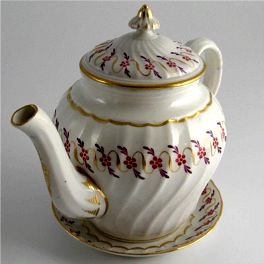 A
very attractive Worcester circular 'shanked' teapot and stand from the 'Flight and
Barr' period of the famous Worcester factory. This elegant teapot and stand are
charmingly decorated with a pattern known as the 'red spot flower' and dates from
c1790.
A
very attractive Worcester circular 'shanked' teapot and stand from the 'Flight and
Barr' period of the famous Worcester factory. This elegant teapot and stand are
charmingly decorated with a pattern known as the 'red spot flower' and dates from
c1790.
The teapot itself, has a circular body which is 'shanked' (spirally moulded) to give a very attractive and well potted body. The shoulder of the teapot is decorated with a hand painted design, 'the red spotted flower'. This is a garland of stylised red flowers formed by five red dots. Each flower has stylised purple foliage at an angle to the flower head. These red dot flowers are linked with a gilded ribbon that oscillates between the flowers. This is a very elegant design for a teapot.
The finial of the lid is a well and finely potted bell flower shape. This type of finial is one that is associated with the Flight and Bar Worcester period. Thus, although this teapot and stand are unmarked, they can be confirmed as Flight and Barr Worcester from this finial alone, apart from the finely potted body and decoration.
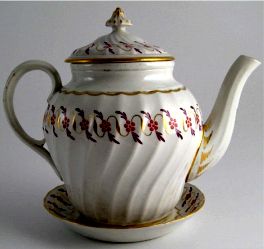
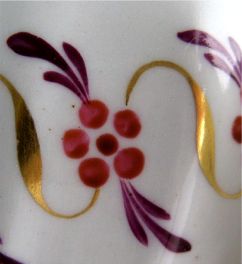
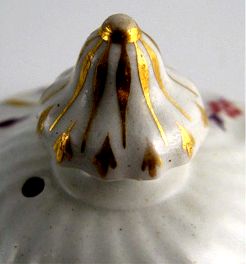
The stand for the teapot is circular in shape with a raised rim. It is shank moulded around the rim and decorated in the same fashion as the teapot. A very fine teapot and stand for the collector of 'Flight & Barr' Worcester.
More details of this item and other tea related antiques can be found by visiting my web site at www.TeaAntiques.com.
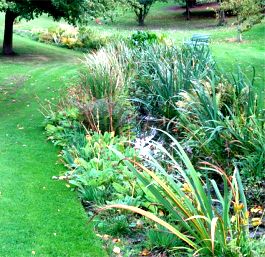
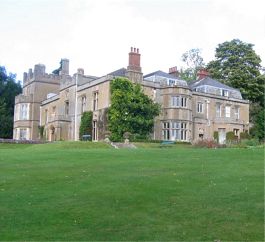 'Titsey'
is a word derived from the Saxon for 'magic spring'. It is indeed a water Spring
in the grounds of Titsey Place from which the estate takes its name. Water was an
all important commodity for any settlement and this spring has been the centre of
a Roman settlement here, through to a religious foundation, to a Tudor manor, Georgian
house and the Victorian style house that we see here today.
'Titsey'
is a word derived from the Saxon for 'magic spring'. It is indeed a water Spring
in the grounds of Titsey Place from which the estate takes its name. Water was an
all important commodity for any settlement and this spring has been the centre of
a Roman settlement here, through to a religious foundation, to a Tudor manor, Georgian
house and the Victorian style house that we see here today.
Titsey Place is a house that has been in the same family for over 400 years, but sadly the last generation had four sons, who were childless and thus there was no direct descendant to whom to leave the house. In an effort to avoid high death duties and the selling off of the estate, they set up the 'Titsey Foundation', which in 1993 opened the estate to the public. The last son, Thomas Leveson Gower, had been the guardian of the Innes family after the death of their father in 1948 and were appointed trusties of the house and estate. The Innes family still stay at the house for several months each year, so it does remain a lived-in home.
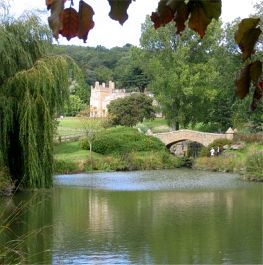
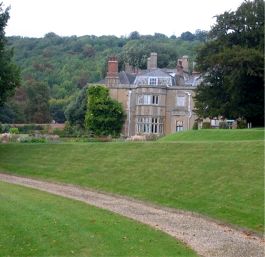
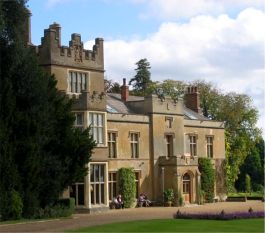 Like
many great estates and houses that have remained in the same family for many generations,
the fortune of the house and estate goes from good to bad times and Titsey is no
exception. It does however, remain one of the largest surviving historic estates
in Surrey.
Like
many great estates and houses that have remained in the same family for many generations,
the fortune of the house and estate goes from good to bad times and Titsey is no
exception. It does however, remain one of the largest surviving historic estates
in Surrey.
The estate was originally purchased in 1534 by Sir John Gresham. Sir John was one of the wealthy mercers, or merchant adventurers of the day. He would trade in exotic goods to sell in England and make his fortune. He was also one time Lord Mayor of London. He was a member of the Mercers' Company, one of twelve Great Livery Companies and traded in spices and silks from the Middle east and timber and skins from the Baltic.
Having amassed a great fortune, at a time when lands were being confiscated and sold off by King Henry VIII, Sir John invested his fortune in lands and bought the manors of Titsey, Limpsfiled, Tatsfield, Westerham, Lingfield and Sanderstead on the Kent-Surrey borders. He also bought properties in Norfolk and Buckinghamshire.
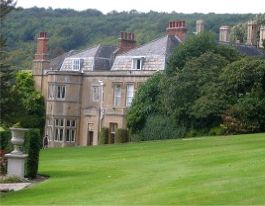 Sir
John's eldest son, William, inherited the property at Titsey and spent much of his
time improving the house and estate. He built a new house here, but this was demolished
in the eighteenth century, with the exception of a tiny part, that was kept for
the servant quarters of the new house.
Sir
John's eldest son, William, inherited the property at Titsey and spent much of his
time improving the house and estate. He built a new house here, but this was demolished
in the eighteenth century, with the exception of a tiny part, that was kept for
the servant quarters of the new house.
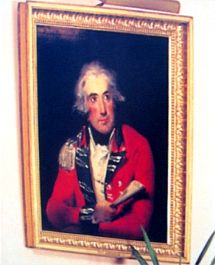 In
the early eighteenth century the house went into decline following the spend thrift
ways of the then owner, Sir Marmaduke Gresham. It was then left to his second
son John to restore the house and family fortunes. He was fortunate to marry an
heiress, Henrietta Maria, daughter of Sir Kenrick Clayton. He also inherited a second
fortune from his mother's brother, thus restoring the family fortune.
In
the early eighteenth century the house went into decline following the spend thrift
ways of the then owner, Sir Marmaduke Gresham. It was then left to his second
son John to restore the house and family fortunes. He was fortunate to marry an
heiress, Henrietta Maria, daughter of Sir Kenrick Clayton. He also inherited a second
fortune from his mother's brother, thus restoring the family fortune.
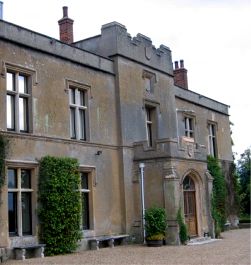 With
this new fortune, he was able to demolish much of the old dilapidated house and
built a smaller red brick house on the site. This house was a traditional Georgian
symmetrical five bay house. It is this house that is the nucleus of the present
house, which was changed by the addition of a tower, bays, crenulations' and the
application of a stucco material over the entire exterior. This more 'fashionable'
and imposing house.
With
this new fortune, he was able to demolish much of the old dilapidated house and
built a smaller red brick house on the site. This house was a traditional Georgian
symmetrical five bay house. It is this house that is the nucleus of the present
house, which was changed by the addition of a tower, bays, crenulations' and the
application of a stucco material over the entire exterior. This more 'fashionable'
and imposing house.
With only a daughter, Katherine Maria, the line continued through her marriage to William Leveson Gower, first cousin of the Marquis of Stafford, later 1st Duke of Sutherland. their Grandson, Granville Levson Gower continued to improve the house and estate by completely remodelling the house, decorating many of the rooms to include the family heraldry of the Gresham, Leveson and Gower families. An enthusiastic historian and archaeologist, he excavated the Roman site at Titsey, some of his finds of roman artefacts are on display within the house, other items are on display at the nearby motor-way services at 'Clackets Lane', which is on the Titsey estate on the M25 motorway.
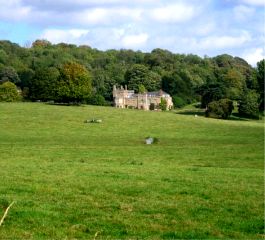
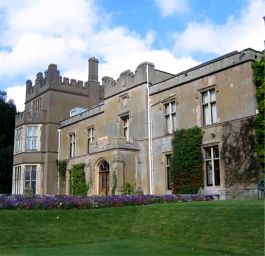
The house is set with sweeping views over quite an open landscape, with a lake, filled from the spring which bubbles up from the ground a short distance from the house. Considering the house is only 20 miles from the centre of London, it is quite peaceful except for the distant noise of the heavy traffic on the M25 which runs through the estate grounds.
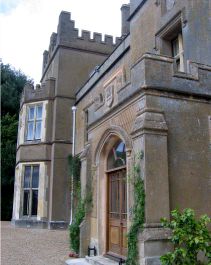
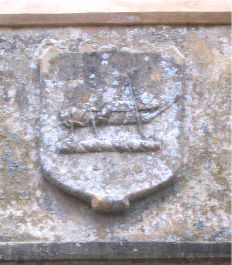 Above
the front door of the house is the Gresham crest, a grasshopper. This grasshopper
crest can be seen on many items in the house.
Above
the front door of the house is the Gresham crest, a grasshopper. This grasshopper
crest can be seen on many items in the house.
The Entrance Hall is stone flagged in Portland stone with a staircase that rises up from the centre of the hall, this replacing the Georgian cantilever stair case that would have run around the walls of the Hall. This later staircase was constructed of cast iron, a new and fashionable material. Many of the changes carried out to the design of the house inside and out were the work of William Atkinson, which included the re-facing of the Georgian red brick house with Roman cement. He made design changes to this hall, including the new staircase, plastered ceiling and the flooring. He also introduced the classical bronze oil lamps positioned under the arch in front of the stairs. These were revolutionary in that they burnt Colza oil fed from a central urn within the lamp. This oil was made from Colza cabbages (rape seed as we know it) which gave a much brighter light than conventional lamp oil. It is interesting to observe that hanging from the ceiling above these lamps are the original glass 'smoke domes', there to stop the soot from the lamps from blackening the white ceiling. The Hall contains many fine ancestral painting, by some famous artists including Reynolds and Sir Peter Lely. Above the fireplace is a portrait of William Gresham, son of the purchaser of the Titsey estate.
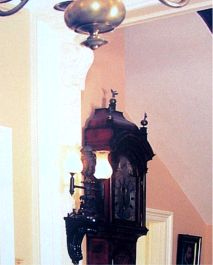
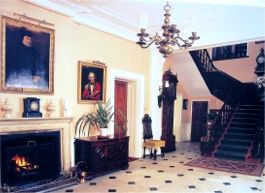
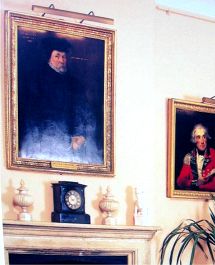
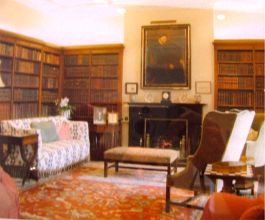 To
the right of the Entrance Hall is the Library, another of
To
the right of the Entrance Hall is the Library, another of
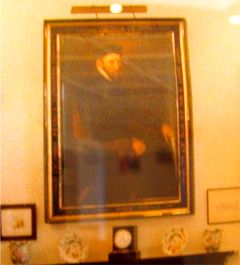 Atkinson's
interiors. Here he was responsible for the black and white marble chimneypiece and
the fitted bookcases in pollard oak from the estate. The pollard oak gives a very
interesting grain that looks more like walnut than oak. These bookcases were designed
to house the family's book collection that they had amassed over the years. Unlike
many houses where books were bought by the yard to fill shelves and impress, this
eclectic mix of books was very much read and enjoyed by the family. Above the fireplace
is a fine portrait of Sir Thomas Gresham, nephew of John Gresham of Titsey and to
whom he was apprenticed.
Atkinson's
interiors. Here he was responsible for the black and white marble chimneypiece and
the fitted bookcases in pollard oak from the estate. The pollard oak gives a very
interesting grain that looks more like walnut than oak. These bookcases were designed
to house the family's book collection that they had amassed over the years. Unlike
many houses where books were bought by the yard to fill shelves and impress, this
eclectic mix of books was very much read and enjoyed by the family. Above the fireplace
is a fine portrait of Sir Thomas Gresham, nephew of John Gresham of Titsey and to
whom he was apprenticed.
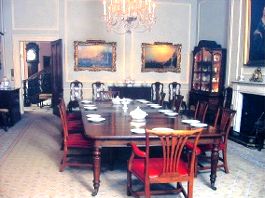 The
next room, for me was the most interesting and beautiful of the rooms, the New Dining
Room. Under Atkinson's redesign of the house, this room was the Drawing Room, but
was made into a dining room in the 1920's as it was more conveniently place for
the kitchens. It is a most elegant and well proportioned room of the Regency style.
It has panelled walls painted in pale blue and white. The blue colour of the walls
was chosen to match the sky of four magnificent Canaletto paintings showing scenes
of Venice. These were commissioned when Canaletto was resident and working in London
in the 1750's. Canaletto would charge for the number of people that were included
in the painting, the more people, the more expensive the painting. Looking carefully
at the paintings it can be seen that the people were added after the buildings had
been completed as you can see through the people the construction of the steps and
buildings against which they had been placed.
The
next room, for me was the most interesting and beautiful of the rooms, the New Dining
Room. Under Atkinson's redesign of the house, this room was the Drawing Room, but
was made into a dining room in the 1920's as it was more conveniently place for
the kitchens. It is a most elegant and well proportioned room of the Regency style.
It has panelled walls painted in pale blue and white. The blue colour of the walls
was chosen to match the sky of four magnificent Canaletto paintings showing scenes
of Venice. These were commissioned when Canaletto was resident and working in London
in the 1750's. Canaletto would charge for the number of people that were included
in the painting, the more people, the more expensive the painting. Looking carefully
at the paintings it can be seen that the people were added after the buildings had
been completed as you can see through the people the construction of the steps and
buildings against which they had been placed.
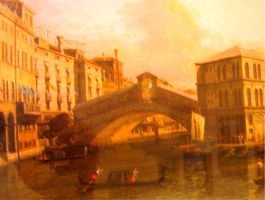
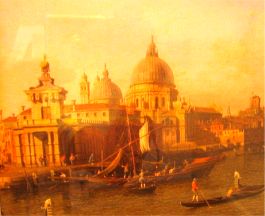
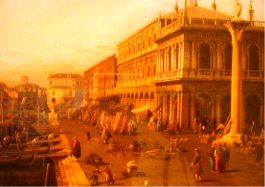
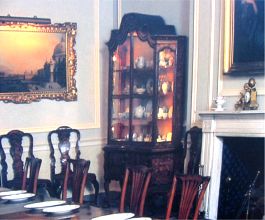 As
well as a large dining table and chairs in eighteenth century style, there are a
magnificent set of Dutch eighteenth century chairs against the walls. These are
particularly interesting as they are inlaid with marquetry which includes shining
white flowers, these made not from Ivory, but Turkey bone. On the dining table are
plates from a huge service made by Daniel of Stoke-on-Trent, c1830 and carry the
Levson Gower coat of arms which includes their motto 'you can break me but I
will not bend'.
As
well as a large dining table and chairs in eighteenth century style, there are a
magnificent set of Dutch eighteenth century chairs against the walls. These are
particularly interesting as they are inlaid with marquetry which includes shining
white flowers, these made not from Ivory, but Turkey bone. On the dining table are
plates from a huge service made by Daniel of Stoke-on-Trent, c1830 and carry the
Levson Gower coat of arms which includes their motto 'you can break me but I
will not bend'.
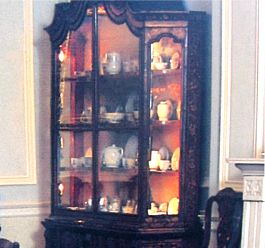 There
is a handsome Dutch cabinet to the left of the fireplace, like the chairs,
delightfully inlaid with marquetry. Within this cabinet are three Chinese export
tea services, commissioned by the family and date from pre 1720. these tea services
were ordered specifically by the family, each having the family 'grasshopper' crest
included in the decoration. At this time, such tea service would be ordered from
China and the designs for the decoration would be sent out to China for them to
copy onto the porcelain. It could take a year or more for the service to be made,
decorated and shipped back to England. Even then, you may find that the design had
not been implemented correctly or worse, the ship has sunk carrying the cargo back
to England, so it was not easy or cheap to acquire such tea service. therefore to
have three services is quite amazing. Two of the services carry the coat of arms
of the family as well as the grasshopper crest, the third service is decorated with
flowers, but still has the 'grasshopper' included.
There
is a handsome Dutch cabinet to the left of the fireplace, like the chairs,
delightfully inlaid with marquetry. Within this cabinet are three Chinese export
tea services, commissioned by the family and date from pre 1720. these tea services
were ordered specifically by the family, each having the family 'grasshopper' crest
included in the decoration. At this time, such tea service would be ordered from
China and the designs for the decoration would be sent out to China for them to
copy onto the porcelain. It could take a year or more for the service to be made,
decorated and shipped back to England. Even then, you may find that the design had
not been implemented correctly or worse, the ship has sunk carrying the cargo back
to England, so it was not easy or cheap to acquire such tea service. therefore to
have three services is quite amazing. Two of the services carry the coat of arms
of the family as well as the grasshopper crest, the third service is decorated with
flowers, but still has the 'grasshopper' included.
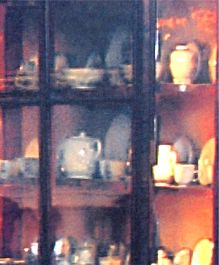
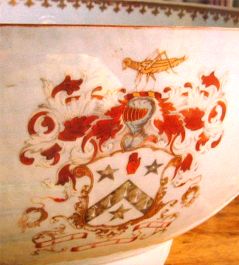
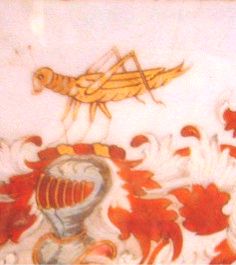
Moving upstairs on the top landing is a cabinet containing some finely decorated eighteenth century Worcester porcelain from a large dinner service, with gros blue ground and painted with classical urns and flowers. On a cabinet stands a solitary piece of eighteenth century French Sèvres porcelain. It is an ice pail that is surmounted by a large gold lion. Originally this was part of a large service. However, during a period when the family fortunes were at a low, they were forced to sell it off, but kept this one piece.
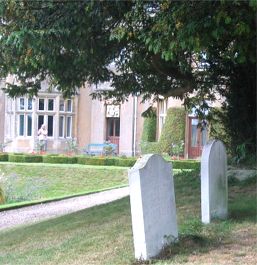
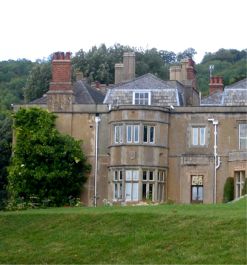 The
Panelled Sitting Room is rather odd in that the walls are covered with dark wood
carved panelling and an open fireplace that is lined with blue and white Delft tiles.
There is a bay window which affords a wonderful view of the gardens, the lake and
the source of the water spring that feeds it. There is also a single yew tree on
the lawn close by. This was once in the church yard of a church that stood there,
along with villagers cottages. However, it was thought that these spoilt the view,
so the owners at the time had the church and village moved to a more 'pleasing'
site out of view. There are a few grave stones sited under the yew tree, but these
are only of family pets.
The
Panelled Sitting Room is rather odd in that the walls are covered with dark wood
carved panelling and an open fireplace that is lined with blue and white Delft tiles.
There is a bay window which affords a wonderful view of the gardens, the lake and
the source of the water spring that feeds it. There is also a single yew tree on
the lawn close by. This was once in the church yard of a church that stood there,
along with villagers cottages. However, it was thought that these spoilt the view,
so the owners at the time had the church and village moved to a more 'pleasing'
site out of view. There are a few grave stones sited under the yew tree, but these
are only of family pets.
In the bay of this room stands a drop leaf oak table around which are a set of four Georgian black painted wheel back chairs.
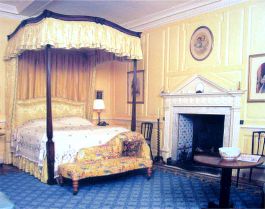
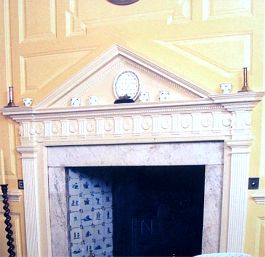 There
is a Georgian bedroom that has been quite recently redecorated in the correct Georgian
style. It is a very elegant bedroom painted in pale yellow. The Georgian sash windows
contain the original thick glazing bars and Crown glass. The Georgian four poster
bed is hung with yellow silk bed hangings.
There
is a Georgian bedroom that has been quite recently redecorated in the correct Georgian
style. It is a very elegant bedroom painted in pale yellow. The Georgian sash windows
contain the original thick glazing bars and Crown glass. The Georgian four poster
bed is hung with yellow silk bed hangings.
Returning downstairs there is The Old Hall, what was part of the old Jacobean house and would have been the servants' quarters. There is a huge open brick-lined fireplace that has a small oven off on the side, which may have been the salt safe or a bread oven. Within glass cabinets there is some fine domestic silver by Paul Storr, the famous nineteenth century silversmith. These items include some serving dishes and a massive salver which bares the family Coat of Arms. there are also three eighteenth century Christening robes, one of which is very elaborate with its roll work front.
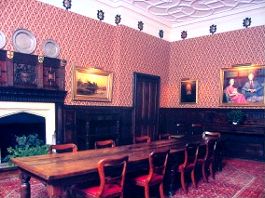
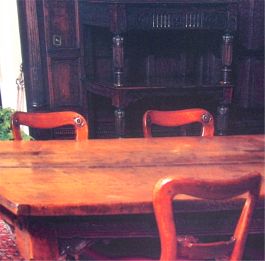 The
Old Dining Room, as it is now called, is in fact the most modern room in the house.
It was added for Granville Levson Gower by Philip Hardwick in 1856. Around the frieze
of the ceiling are shields of all the family heraldic decorations. In the centre
of the room, a massive refectory table in oak around which are a set of oak dining
chairs. A large portrait shows the two last childless brothers, Richard and Thomas
Leveson Gower, to live at Titsey, before leaving it to the Titsey Foundation. It
is an interesting portrait as it shows them dressed in their every day clothes,
including shoes polished to within an inch of their lives! They had four white dogs
that they wanted to be included in the painting, but the artist refused and only
allowed three otherwise he said 'it will look dogged out!'
The
Old Dining Room, as it is now called, is in fact the most modern room in the house.
It was added for Granville Levson Gower by Philip Hardwick in 1856. Around the frieze
of the ceiling are shields of all the family heraldic decorations. In the centre
of the room, a massive refectory table in oak around which are a set of oak dining
chairs. A large portrait shows the two last childless brothers, Richard and Thomas
Leveson Gower, to live at Titsey, before leaving it to the Titsey Foundation. It
is an interesting portrait as it shows them dressed in their every day clothes,
including shoes polished to within an inch of their lives! They had four white dogs
that they wanted to be included in the painting, but the artist refused and only
allowed three otherwise he said 'it will look dogged out!'
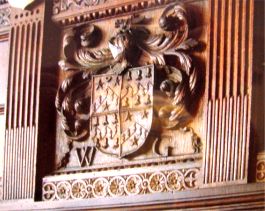
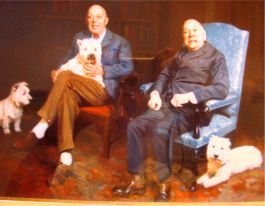
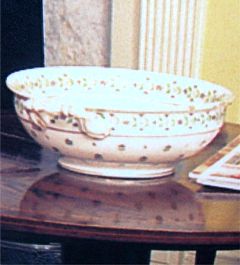 The
final room is The Drawing Room, which has dado height wood panelling around it and
a fireplace that has tiles, each with a 'grasshopper' as the decoration. There is
a cabinet at one end of the room which appears to house part of a large porcelain
service in a charming 'cornflower' pattern. However, upon close inspection this
set is made up of three manufacturers; Paris (Dihl & Guerhard), Derby and Worcester.
There is also a delightful Queen Anne walnut cabinet in which is part of an eighteenth
century Chelsea-Derby green floral pattern tea set.
The
final room is The Drawing Room, which has dado height wood panelling around it and
a fireplace that has tiles, each with a 'grasshopper' as the decoration. There is
a cabinet at one end of the room which appears to house part of a large porcelain
service in a charming 'cornflower' pattern. However, upon close inspection this
set is made up of three manufacturers; Paris (Dihl & Guerhard), Derby and Worcester.
There is also a delightful Queen Anne walnut cabinet in which is part of an eighteenth
century Chelsea-Derby green floral pattern tea set.
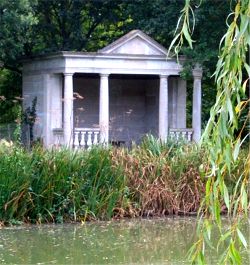
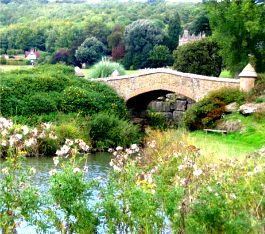
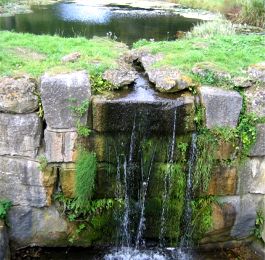
The grounds surrounding the house are delightful to stroll round. There are formal and informal areas, as well as the lake with its bridges, cascade and temple.
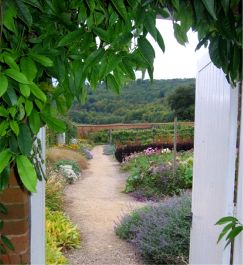
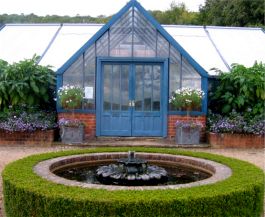
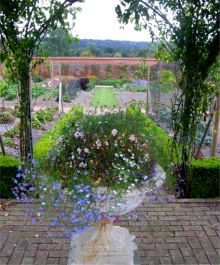
The old walled garden was a particular treat to see, with its very well tended fruit, vegetables and flowers. This garden was completely restored in 1996 and illustrates perfectly a Victorian working walled garden.
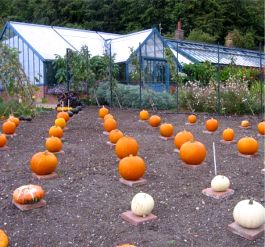
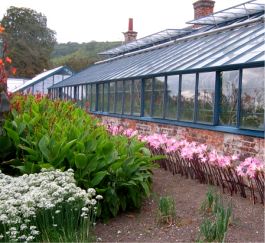
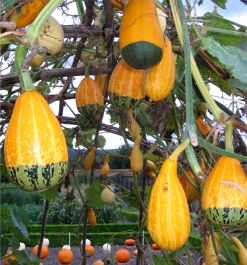
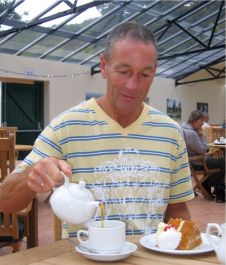
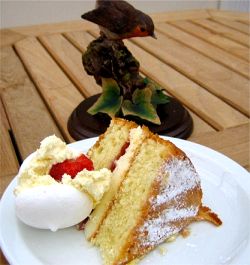 To
end the visit to Titsey, there is a modern tearoom, which has an outdoor courtyard
with tables and chairs if the weather is fine enough. They serve a variety of cakes
and scones. I had a slice of Victoria sponge cake and a strawberry and cream meringue
with my tea. A very pleasant way to end my visit. Titsey, whilst not grand, is an
interesting house to visit. For those who love porcelain, there are some beautiful
pieces to admire, and includes a good selection of tea wares. the three Chinese
tea services were a real delight for me. I hope that you may enjoy a visit there
one day.
To
end the visit to Titsey, there is a modern tearoom, which has an outdoor courtyard
with tables and chairs if the weather is fine enough. They serve a variety of cakes
and scones. I had a slice of Victoria sponge cake and a strawberry and cream meringue
with my tea. A very pleasant way to end my visit. Titsey, whilst not grand, is an
interesting house to visit. For those who love porcelain, there are some beautiful
pieces to admire, and includes a good selection of tea wares. the three Chinese
tea services were a real delight for me. I hope that you may enjoy a visit there
one day.
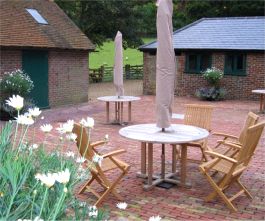
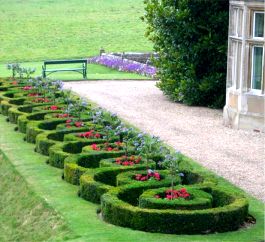
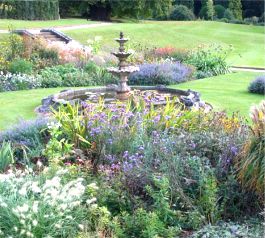
To review past newsletters, just follow this link:
Past newsletters.
To subscribe to this free newsletter -
Click here